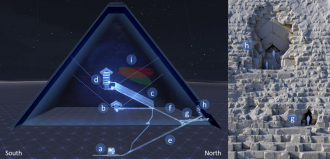Media release
From:
1. Archaeology: Exploring Khufu’s Pyramid *IMAGE*
A previously unexplored corridor-shaped structure in Khufu’s Pyramid, discovered in 2016, has been characterized in detail, without entering it, reports a Nature Communications paper. The findings may improve our understanding of how the pyramid was constructed and the role of the Chevron structures observed on Khufu’s Pyramid.
Khufu’s Pyramid was built about 4,500 years ago and is one of the largest archaeological monuments in the world. In 2016 and 2017, a series of new voids were discovered inside the pyramid, including a "Big Void" and a corridor-shaped structure located behind the Chevron structures on the north side of the pyramid, named the North Face Corridor. However, the precise position and shape of the North Face Corridor remain unknown.
Using a technique called cosmic-ray muon radiography, Sébastien Procureur, Kunihiro Morishima, and colleagues measured the size, shape and location of the North Face Corridor in detail, without entering it. The corridor measures about 9 m in length, and has a transverse section of about 2 m by 2 m. The technique detects cosmic radiation passing through the pyramid, allowing the authors to determine the size of the corridor because a solid pyramid would allow less radiation to reach the detectors compared to void space. Although the corridor was discovered a few years ago, this study gives a more detailed view of its shape and location.
Multimedia




 International
International
![East-West cut view of the Great Pyramid and front view of the North face Chevron area. a Subterranean chamber, b queen’s chamber, c grand gallery, d king’s chamber, e descending corridor, f ascending corridor, g al-Ma’mun corri[1]dor, h north face Chevron area, i ScanPyramids Big Void with horizontal hypothesis (red hatching) and inclined hypothesis (green hatching) as published in November 20176 . All these images were obtained from a 3D modelization using dedicated laser surveys and photogrammetry data](https://www.scimex.org/newsfeed/cosmic-radiation-reveals-the-hidden-insides-of-the-great-pyramid-of-giza/khufus-pyramid_Nature-comms_image.png)


